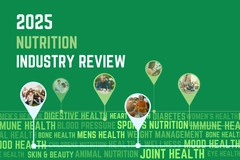
- Industry news
Industry news
- Category news
- Reports
- Key trends
- Multimedia
Multimedia
- Journal
- Events
- Suppliers
Suppliers
- Home
- Industry news
Industry news
- Category news
- Reports
- Key trends
- Multimedia
Multimedia
- Events
- Suppliers
Suppliers
Researchers peg 3D printed food as nutritious solution to growing population and climate concerns

10 Aug 2022 --- To address food supply concerns, a Singapore University of Technology and Design research team is developing a systematic and effective 3D food printing technique to serve alternative protein sources like algae, plants and insects.
“Three-dimensional food printing makes a strong case for achieving customization or personalization of the food habits of consumers,” professor Yi Zhang, principal investigator, University of Electronic Science and Technology of China, tells NutritionInsight.
“It can also be used to satisfy the personal quirks of average consumers who wish to incorporate taste, nutrition and aesthetics. With this technology, consumers have a say in the design selection and process of their food of choice.”
The researchers note that people have already started using alternate sources of proteins from plants, algae, and insects in several areas of Africa, Asia and South America to produce nutrient-dense, sustainable food.
“With our findings, the industry players can use diverse sources of food which may have been unpalatable in terms of taste or appearance until now,” Aakanksha Pant, corresponding author and research associate at Singapore University of Technology and Design, also tells NutritionInsight.
“For instance, insects have been part of traditional diets in certain cultures. However, wider acceptability may be attained by changing how insect-incorporated dishes are presented to the consumers.”
“The appearance and taste of such alternative proteins can be disconcerting for many. This is where the versatility of 3D food printing rises to the challenge as it can transform how food is presented and overcome the inertia of consumer inhibitions,” says Chua Chee Kai, co-author of the study, Singapore University of Technology and Design.
For instance, typical foods like carrots can be combined with alternative proteins like crickets to provide a more recognizable flavor for customers. A 3D food printer can then extrude this blend of carrots and crickets to produce a visually appealing dish.
Greenhouse gases and environmental concerns
The researchers suggest that 3D printed food could alleviate concerns over rising greenhouse gas emissions and increased water and land use due to conventional methods of rearing animals for food.
“Utilizing the 3D printing technology can help mitigate food waste generation. Firstly, by looking at potential ingredients for 3D printing using food waste that is nutritious and edible. Secondly, by printing what is required for consumption instead of storing and packaging formed products with a finite expiry date and contribute a lot to energy needs,” says Pant.
 The 3D printing technique may aid in the demand for food high in protein that is anticipated to rise along with the aging and growing population (Credit: Singapore University of Technology and Design).“This research study can also be generalized for other food ingredients and the response of the food inks like texture, printability and water seepage may be included for optimization.”
The 3D printing technique may aid in the demand for food high in protein that is anticipated to rise along with the aging and growing population (Credit: Singapore University of Technology and Design).“This research study can also be generalized for other food ingredients and the response of the food inks like texture, printability and water seepage may be included for optimization.”
“The response surface method approach may lead researchers to adopt a similar method for optimizing 3DFP food inks constituting complex multicomponent food ingredients,” adds Pant.
Determining technique for alternative proteins
The researchers developed a systematic engineering strategy for effectively adding alternative proteins into food inks. The study team minimized time and resources by limiting the number of experimental runs while optimizing protein inks.
“Alternative proteins may become our main source of protein intake in the future,” says Zhang.
“This study proposes a systematic engineering approach to optimizing food inks, enabling easy creations and customizations of visually pleasing, flavourful and nutritionally adequate food enhanced with alternative proteins. We hope our work would encourage consumers to eat more of these unfamiliar but sustainable food items”.
 According to researchers, alternative proteins may become the primary protein source in the future.Using the central composite design approach, the study team optimized the protein ink compositions with three variables – carrot powder, proteins, and xanthan gum. In addition to flavor, nutrients, and color, carrot powder assisted in providing the inks used to create mechanical strength.
According to researchers, alternative proteins may become the primary protein source in the future.Using the central composite design approach, the study team optimized the protein ink compositions with three variables – carrot powder, proteins, and xanthan gum. In addition to flavor, nutrients, and color, carrot powder assisted in providing the inks used to create mechanical strength.
The research also experimented with different proteins like sericin, soy, spirulina, crickets, and black soldier fly larvae. Experimentally developed inks were tested for 3D printability and syneresis, with optimized inks obtaining the highest printability and the lowest syneresis.
The future of food and meat alternatives?
Industry players have been using 3D printing to alter foods’ texture and sensory experience. However, a food expert claimed that the 3D technology is being held back from dominating the market by factors including cost, capacity and a shortage of printable ingredients.
Food scientists previously engineered the texture of chocolate through 3D printing. The scientists noted that the ideal textural experience in the case of 3D printed chocolate largely depends on structure, specifically when several fractures can be coded into its surface.
In other developments, MeaTech 3D and Umami Meats signed a memorandum of understanding for the joint development of 3D printed cultured structured seafood. Meanwhile, in the plant-based meat space, Israeli company Redefine Meat introduced 3D printed vegetable meat that “bleeds” like typical beef and lamb cuts.
In the supplement space, researchers from the Indian Institute of Food Processing Technology used 3D printing technology to transport resveratrol and curcumin within supplements throughout the human body as these are usually difficult for the body to absorb.
By Nicole Kerr











